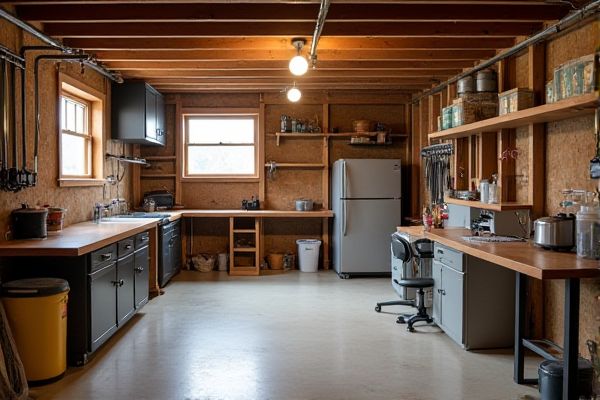
Vertical storage maximizes space by utilizing tall shelving units that keep items organized and accessible without occupying much floor area, ideal for small basements. Horizontal storage, on the other hand, involves spreading items across low, wide shelves or bins, which can be useful for storing larger or heavier objects; discover which method suits Your basement needs best by exploring the full article.
Table of Comparison
| Feature | Vertical Storage Basement | Horizontal Storage Basement |
|---|---|---|
| Space Efficiency | Optimizes floor space by stacking items upwards | Maximizes floor area coverage with side-by-side storage |
| Accessibility | Requires climbing or reaching higher shelves | Items stored at ground level for easy access |
| Capacity | Higher vertical capacity for bulk storage | Limited by horizontal floor space availability |
| Structural Requirements | Needs strong shelving and ceiling height | Requires wide, open floor plan |
| Cost | Potentially higher due to specialized shelving | Generally lower with basic shelving units |
| Safety | Risk of falling items from height | Lower injury risk, items at ground level |
| Ideal Use Case | Small footprint, high volume storage | Large floor area, frequent access needs |
Introduction to Basement Storage Solutions
Basement storage solutions offer a range of methods tailored to maximize space efficiency and accessibility. Vertical storage systems utilize wall-mounted shelves, hooks, and tall cabinets, optimizing unused vertical space to keep floors clear and reduce clutter. In contrast, horizontal storage prioritizes low-profile units like bins, drawers, and platform shelves, making it easier to stack and access items spread across the basement floor.
Understanding Vertical Storage Systems
Vertical storage systems in basements maximize space efficiency by utilizing upward wall areas for shelving, cabinets, or racks, allowing for organized storage in compact footprints. These systems reduce clutter and improve accessibility by keeping items off the floor compared to traditional horizontal storage, which often occupies significant floor space. Integrating vertical storage solutions helps maintain a tidy basement environment while optimizing storage capacity in confined or limited areas.
Overview of Horizontal Storage Approaches
Horizontal storage in basements typically involves shelving units, cabinets, or stackable containers arranged side by side to maximize floor space while providing easy access to items. This approach is ideal for storing bulkier items like holiday decorations or seasonal gear, allowing you to spread out belongings without overcrowding. Choosing sturdy materials and adjustable shelves enhances durability and customization for your unique storage needs.
Space Utilization: Vertical vs Horizontal
Vertical storage maximizes space utilization in basements by allowing you to stack items upward, freeing up valuable floor area for movement or additional storage. Horizontal storage spreads items across the floor, consuming more square footage and limiting flexibility in small basements. Efficient vertical storage solutions optimize your basement's cubic space, enhancing organization without overcrowding the room.
Accessibility and Convenience Comparison
Vertical storage in basements maximizes space by utilizing height, making frequently used items easier to reach without excessive bending or stretching. Horizontal storage offers broader surface areas, ideal for large or bulky items but may require more effort to access things stored at the back. Your choice depends on the balance between space efficiency and ease of access for daily use.
Safety Considerations in Storage Orientation
Vertical storage in basements enhances safety by minimizing water exposure during flooding, reducing mold risks and structural damage compared to horizontal storage. Proper vertical shelving ensures better air circulation, decreasing moisture accumulation and potential pest infestations. Secure fastening of vertical units prevents toppling hazards, promoting safer access in confined basement spaces.
Cost Implications of Storage Choices
Vertical storage in basements typically maximizes space efficiency, reducing the need for additional shelving units and lowering overall costs by utilizing wall height. Horizontal storage requires more floor space, which may necessitate larger basement areas or costly reorganizations to accommodate bulky items. Your choice impacts initial investment and long-term expenses, influencing the budget for storage solutions in your basement renovation.
Impact on Basement Organization and Aesthetics
Vertical storage maximizes basement floor space by utilizing wall height, creating a more open and organized environment that reduces clutter. Horizontal storage, often involving shelves or cabinets along the floor, provides easy access but can make the basement feel crowded and limit movement. You can enhance your basement's aesthetics and functionality by choosing vertical storage solutions that promote a clean, streamlined appearance while maintaining efficient organization.
Maintenance and Durability: Pros and Cons
Vertical storage in basements often requires less floor space and allows for easier cleaning and maintenance, but may be prone to tipping if not properly anchored. Horizontal storage provides greater weight distribution and stability, enhancing durability for heavy or bulky items, though it can accumulate dust and moisture more easily, increasing maintenance needs. Your choice depends on the balance between space efficiency and the specific maintenance demands of the items stored.
Choosing the Right Storage for Your Basement Needs
Vertical storage in basements maximizes floor space by utilizing wall height, making it ideal for smaller areas and providing easy access to frequently used items. Horizontal storage offers greater capacity for bulkier items and is better suited for basement layouts with ample floor space, allowing organized placement of larger boxes and equipment. Selecting the right storage depends on the basement's dimensions, the types of items stored, and accessibility requirements, balancing efficiency and convenience.
 homyna.com
homyna.com